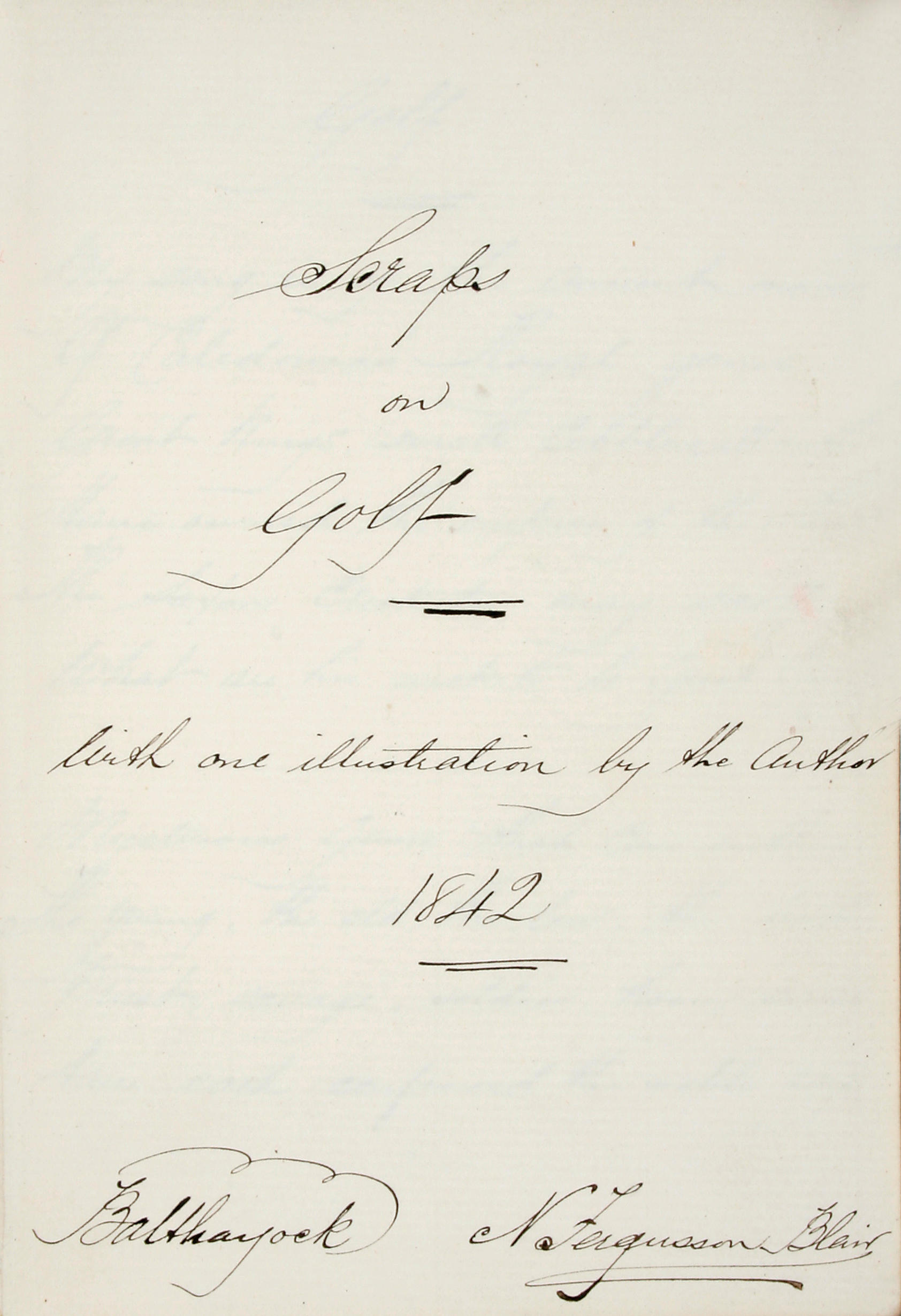Lot of items from the personal collection of famed theater actor William J. Ferguson, cast member of Our American Cousin and witness to Lincoln's assassination. This exceedingly rare and unique combination of assassination memorabilia includes a large piece of Presidential Box wallpaper as well as Ferguson's hand drawn diagrams of Ford's Theatre and the path of John Wilkes Booth's escape. William J. Ferguson (1845-1930) was one of the most well-known actors of the late nineteenth and early twentieth century. In 1865, however, he was just starting his career working as a "call boy" and occasional player at Ford's Theatre. On the night of April 14, 1865, Ferguson was called upon to fill in for another actor who had become ill, and in doing so his life would be forever changed. Standing just off stage beside legendary British actress Laura Keene, Ferguson had a direct line of sight to President Lincoln's box and witnessed the assassination. Booth then passed directly between Keene and Ferguson as he fled the scene. Either from fear that his southern roots would somehow implicate him in the crime or possibly out of deference to fellow actor Edwin Booth, brother of John Wilkes Booth, Ferguson did not share details of his experience until nearly half a century later. Newspaper and magazine clippings included in this collection indicate that in approximately 1913 Ferguson began discussing the assassination more openly, often in interviews tied to publicity for his roles on stage and screen. Ferguson's definitive account of his recollections from the night of the assassination was published in his 1930 book I Saw Booth Shoot Lincoln. Ferguson's account of the assassination is notable in that it contradicts some long-held assertions about the night of the assassination including that Booth did not pause in his flight to shout "Sic semper tyrannis!" as he crossed the stage. In his book I Saw Booth Shoot Lincoln, Ferguson writes on pages 58/59, “From the wall where I saw Mr. Lincoln rest his head, I stripped away a length of the red-flowered wall-paper." Measuring approximately 9.25 x 7 in., the piece of Presidential Box wallpaper in this collection is much larger than that described by Ferguson in his book, a discrepancy that cannot be completely explained. The wallpaper is deep red with a vertical floral stripe pattern alternated with lighter red leaves on stems. Pattern matches samples shown on websites of Ford’s Theatre and the Lincoln Financial Foundation Collection. Verso has hand written ink notation “Wall Paper from off the spot on Wall where his head rested when shot” and “President Lincoln’s Box Ford’s Theatre Washington D.C. U. S. {April 14, 1865}/Wm. J. Ferguson Eye Witness.” Paper is very worn along creases and in some places fragments of the pattern are completely removed from the textile backing, however, pattern color remains vibrant and pattern is clearly visible. Wallpaper remnants from assassination are relatively rare at auction, and the larger size of this fragment makes it unusual. Also included with the collection are Ferguson's three hand drawn diagrams of Ford's Theatre and Booth's movements on the night of Lincoln's assassination. These never before published diagrams will no doubt add to the discussion and even controversy which still surround the aftermath of the assassination, particularly with regard to John Wilkes Booth's flight from the theatre and Laura Keene's path to the Presidential Box. Diagram 1 is titled “How Booth escaped follow the darts” and is signed “Wm. J. Ferguson” with notation on top left that reads “These Dimensions are correct This plan has never been published The interior of theater was demolished soon after assassination.” Diagram shows Lincoln’s view of the stage from the President’s Box and “darts” or arrows show how Ferguson viewed Booth’s escape across the stage, through the back hallway, and out the back door into the alley. Measures approx. 7.75 x 5.75 in. Diagram drawn on blue l
Lot of items from the personal collection of famed theater actor William J. Ferguson, cast member of Our American Cousin and witness to Lincoln's assassination. This exceedingly rare and unique combination of assassination memorabilia includes a large piece of Presidential Box wallpaper as well as Ferguson's hand drawn diagrams of Ford's Theatre and the path of John Wilkes Booth's escape. William J. Ferguson (1845-1930) was one of the most well-known actors of the late nineteenth and early twentieth century. In 1865, however, he was just starting his career working as a "call boy" and occasional player at Ford's Theatre. On the night of April 14, 1865, Ferguson was called upon to fill in for another actor who had become ill, and in doing so his life would be forever changed. Standing just off stage beside legendary British actress Laura Keene, Ferguson had a direct line of sight to President Lincoln's box and witnessed the assassination. Booth then passed directly between Keene and Ferguson as he fled the scene. Either from fear that his southern roots would somehow implicate him in the crime or possibly out of deference to fellow actor Edwin Booth, brother of John Wilkes Booth, Ferguson did not share details of his experience until nearly half a century later. Newspaper and magazine clippings included in this collection indicate that in approximately 1913 Ferguson began discussing the assassination more openly, often in interviews tied to publicity for his roles on stage and screen. Ferguson's definitive account of his recollections from the night of the assassination was published in his 1930 book I Saw Booth Shoot Lincoln. Ferguson's account of the assassination is notable in that it contradicts some long-held assertions about the night of the assassination including that Booth did not pause in his flight to shout "Sic semper tyrannis!" as he crossed the stage. In his book I Saw Booth Shoot Lincoln, Ferguson writes on pages 58/59, “From the wall where I saw Mr. Lincoln rest his head, I stripped away a length of the red-flowered wall-paper." Measuring approximately 9.25 x 7 in., the piece of Presidential Box wallpaper in this collection is much larger than that described by Ferguson in his book, a discrepancy that cannot be completely explained. The wallpaper is deep red with a vertical floral stripe pattern alternated with lighter red leaves on stems. Pattern matches samples shown on websites of Ford’s Theatre and the Lincoln Financial Foundation Collection. Verso has hand written ink notation “Wall Paper from off the spot on Wall where his head rested when shot” and “President Lincoln’s Box Ford’s Theatre Washington D.C. U. S. {April 14, 1865}/Wm. J. Ferguson Eye Witness.” Paper is very worn along creases and in some places fragments of the pattern are completely removed from the textile backing, however, pattern color remains vibrant and pattern is clearly visible. Wallpaper remnants from assassination are relatively rare at auction, and the larger size of this fragment makes it unusual. Also included with the collection are Ferguson's three hand drawn diagrams of Ford's Theatre and Booth's movements on the night of Lincoln's assassination. These never before published diagrams will no doubt add to the discussion and even controversy which still surround the aftermath of the assassination, particularly with regard to John Wilkes Booth's flight from the theatre and Laura Keene's path to the Presidential Box. Diagram 1 is titled “How Booth escaped follow the darts” and is signed “Wm. J. Ferguson” with notation on top left that reads “These Dimensions are correct This plan has never been published The interior of theater was demolished soon after assassination.” Diagram shows Lincoln’s view of the stage from the President’s Box and “darts” or arrows show how Ferguson viewed Booth’s escape across the stage, through the back hallway, and out the back door into the alley. Measures approx. 7.75 x 5.75 in. Diagram drawn on blue l




/108572/Internet%20Image%201.jpg)









Testen Sie LotSearch und seine Premium-Features 7 Tage - ohne Kosten!
Lassen Sie sich automatisch über neue Objekte in kommenden Auktionen benachrichtigen.
Suchauftrag anlegen